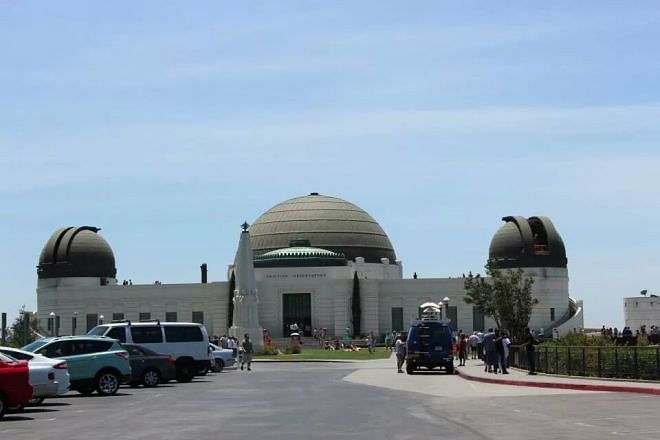Griffith Observatory: Inspiring the future generation
Griffith Observatory: Inspiring the future generation

GRIFFITH Observatory, an icon of Los Angeles, is the foremost leader in public astronomy and a hugely popular public attraction. The Observatory is located on the southern slope of Mount Hollywood in Griffith Park at 1,134 feet above sea level. We visited the observatory a few days back and spent several hours appreciating the extensive array of space and science related displays. Admission to the Observatory is free in accordance with Griffith's wishes.
12.20 km2 of land surrounding the observatory was donated to the City of Los Angeles by Colonel Griffith J. Griffith in 1896. In his will Griffith also set aside funds to build an observatory, exhibit hall and planetarium on the donated land. Griffith wanted the public to access and appreciate the exhibits of science, particularly space science, kept in the observatory without expert knowledge on the subject. Reputed astronomers, architects and engineers helped design and construct the observatory that opened for public viewing on May 14, 1935. As we entered the building we came into the Central Rotunda that features painter Hugo Ballin's mural on the ceiling and a Foucault pendulum hanging from it, which was designed to demonstrate the rotation of the earth.
The observatory is divided into six sections. The W. M. Keck Foundation Central Rotunda, where we were standing, the Ahmanson Hall of the Sky located in the east wing, the Wilder Hall of the Eye located in the west wing, the Cosmic Connection -- a 150 feet long hallway connecting the main building and the underground exhibits -- the Gunther Depth of Space Hall located in the lower level of the observatory, and the Edge of Space Mezzanine.
The centerpiece of the Ahmanson Hall of the Sky is a large solar telescope projecting images of the sun. Exhibits include an illuminated periodic table of the elements, path of the sun and stars, the seasons, the phases of the moon, tides and eclipses. The Wilder Hall of the Sky focusses on astronomical tools like telescopes and how they evolved over time. Other exhibits also include a huge Tesla Coil, and a Camera Obscura kept inside a completely dark room that uses mirrors and lenses to project light on a flat surface.
The entry to the Cosmic Connection is marked by the Big Bang. The tunnel also depicts time that has elapsed since its birth and the history of the Earth. The Gunther Depth of Space Hall is dominated by a scale model of the solar system. The planets are shown relative to the size of the sun, which is represented by the Leonard Nimoy Event Horizon Theater. Below each planet is a scale showing each person's weight on it and other related parameters. The 150ft by 20ft photograph hanging on the wall, dubbed the 'Big Picture,' shows a portion of the Virgo Cluster of galaxies.
A bronze statue of Albert Einstein sitting on a bench ponders in the Depth of Space. In an adjacent room are two paper roll seismographs, one is attached to the bedrock and measures the seismic activities of the area, the other tracks the motion of visitors in the room. The Edge of Space Mezzanine overlooks the Gunther Depth of Space Hall and focusses on objects like meteorites and displays an asteroid impact simulator.
The observatory has featured in a large number of films, the most recent being Valentine's Day (2010), Terminator Salvation (2009), Yes Man (2008), Transformer (2007), Charlie's Angels : Full Throttle (2003) etc. The James Dean film Rebel without a Cause (1955) helped to make it an international emblem of Los Angeles. The Tunnel Entrance to the observatory on Mount Hollywood drive is the entrance to Toon Town in the movie Who Framed Roger Rabbit (1988).
The observatory appeared in a large number of episodes in various TV shows like The Amazing Race, 2010, MTV Video Music Award, The Wonder Years, Mission Impossible, MacGyver, Star Trek Voyager, The Man from U.N.C.L.E. etc.
The observatory offers stunning view of the Los Angeles Basin, including Downtown Los Angeles to the southeast, Hollywood to the south and the Pacific Ocean to the southwest.
The writer is Professor of Physics Jahangirnagar University, Fellow of the Royal Astronomical Society. Currently on a private visit to the University of California, Riverside, U.S.A.